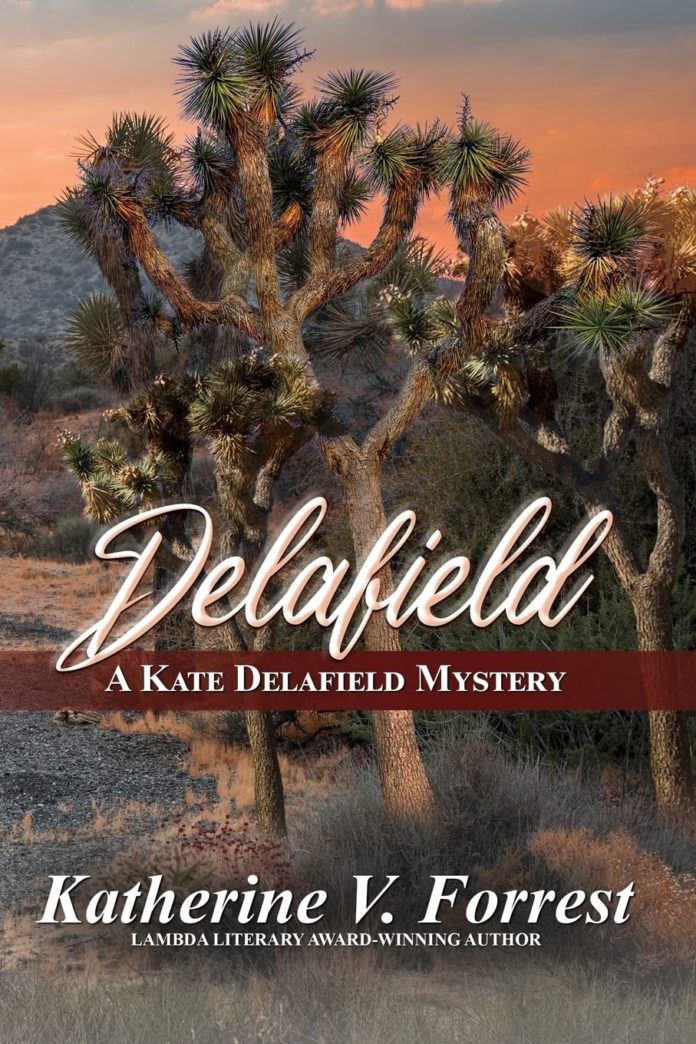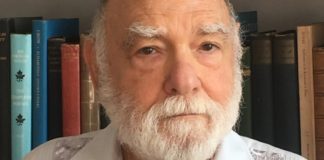
BEGINNING IN THE last part of the century, crime fiction underwent a sea change as writers from communities that had served as the demimonde of classic noir — exotic and/or underworld backdrops for the antics of white, straight, male protagonists — took center stage to tell their stories in their own voices. These included feminist writers (Sara Paretsky), Black writers (Walter Mosley, Paula L. Woods), Latinx writers (Manuel Ramos, Lucha Corpi), and a group of gay and lesbian writers among whom Katherine V. Forrest is one of the most revered.
Forrest is a genre-spanning writer whose work encompasses science fiction, romance, and political novels written over a 40-year period since the publication of her first book, Curious Wine, in 1983. An LGBTQ literary icon, she remains — as do so many other accomplished queer writers — less well known to the general reading public despite critical praise for her Kate Delafield mysteries, her best-known work.
Forrest introduced Kate Delafield, an LAPD homicide detective, in 1984’s Amateur City. Delafield, the 10th volume, opens in 2012 with Kate now retired and living in a small desert community in Yucca Valley. Estranged from her longtime partner, hanging on to newfound sobriety by her fingernails, and suffering from PTSD after decades of working bloody crime scenes and depraved murders, Delafield is not doing well. It doesn’t help that a woman named Ellie Shuster who Delafield helped convict of the murder of her own daughter, April — wrongfully as DNA evidence has belatedly proved — is out of prison and threatening to kill her.
Kate reopens the 20-year-old case to track down the actual killer, not so much to save her life but because she believes herself morally obligated to rectify her mistake. Meanwhile, a wealthy woman named Geneva Fallon (“Fallon as in talon, Kate thought”), wants to hire Kate to deliver a quarter-million dollars as reparations to Natalie Rostow, a high school teacher whose life a teenaged Fallon ruined when she outed her. And then, of course, Kate has to find Ellie Shuster before Shuster can kill her.
Delafield is intended, and can be read, as a stand-alone novel, but for fans of Forrest’s troubled detective, it’s also the culmination of the series. Each of the three story lines — Ellie Shuster’s death threats, the reinvestigation into April Shuster’s murder, and Fallon’s desire to make restitution to Natalie Rostow — recall people and events in Kate’s past that represent unfinished business she can no longer avoid if she hopes to start healing her battered soul.
Fallon’s request introduces into the book what may be the central theme of the entire series: living in the closet. Kate Delafield spent her entire LAPD career, as she remarks, “buried so deep in the closet you couldn’t have found me with a floodlight.” Her closetedness is crucial to understanding who she is and, by extension, generations of gay men and lesbian women in the dark decades before Stonewall and its aftermath. Through Delafield, Forrest explores how the closet fractures and deforms personality in a way that no other contemporary queer writer has.
When we first meet Kate in Amateur City, she’s still mourning the death in a car accident of her partner of 12 years, Anne. Deeply committed, the couple nonetheless was forced to conceal all traces of their relationship to protect their livelihoods and reputations. This concealment extended to the very home they shared. As Kate recalls in Delafield: “They’d had to have a second bedroom. Anne kept her clothes in its closet, arranged a collection of hairbrushes and on its dresser, lingerie in the drawers. This protected them from Anne’s relatives and in the event of unexpected visitors to the house.” The secrecy also meant they could not allow themselves to form close relationships at work lest their colleagues suss out details of their private lives. “Kate was reassigned occasionally and able to keep her personal interactions with police colleagues to a minimum […] Ann left teaching jobs after three or four years […] before parents and especially colleagues could connect too many dots to her personal life.” It also meant that on the day Kate was called into her lieutenant’s office to be informed that her “roommate” had been killed, “I just stood there telling myself over and over: don’t react, don’t cry, don’t even speak.”
Some readers may find it hard to imagine a world in which, for LGBTQ people, even one’s home was not a safe space and news of the death of a partner had to be received stone-faced, but as Delafield reminds us, that world existed within living memory; the two met in the late 1960s and Ann would have died in the late 1970s. Nor is it simply a memory. From Florida’s “Don’t Say Gay” law to Texas’s attack on transgender children and their families, it’s quite clear that a significant part of American society would like to drive LGBTQ people back into the closet. To that extent, Delafield cannot be read merely as a historical document, but as a cautionary tale — all the gains made by the queer community, as with any minority group, are reversible if the majority’s prejudices can be weaponized against it.
It’s important to Kate’s character that the reader understand it wasn’t shame about her homosexuality that kept Kate closeted. Never in the series does she express moral or religious qualms or any guilt about being gay — far from it: she despises the bigotry, religious and otherwise, directed at her kind. What she cannot reconcile with her homosexuality is the career path she chose out of her desire to do some good in the world; joining the LAPD when that department was even more notorious for racism, homophobia, and misogyny than it is now. Being queer in the last decades of the 20th century was no picnic under the best of circumstances, but Delafield’s career choice looks like an act of pure masochism.
Except it’s not. The implicit point Forrest is making throughout the series is that Delafield’s professional and personal struggles are the result of society’s relentless and punitive attacks on queer people and not Delafield’s homosexuality. Had she been born 30 years later, in the 1980s rather than the 1950s, she could have served as a police officer as an openly gay woman. While police forces are still not the friendliest workplaces for LGBTQ people, queer cops today may not have to fear being ordered into potentially lethal situations with no backup, as was famously alleged in a 1988 lawsuit against LAPD by its first openly gay officer.
What would have happened to her and Anne had they been exposed as queer in the unenlightened 1960s or ’70s? When Kate finds Natalie Rostow, the high school teacher Geneva Fallon outed, she also learns what might have been. After being exposed by Fallon, Rostow lost her job and everything else: her lover, her family, her friends. She tells Kate, “Geneva Fallon dropped an atomic bomb on my life,” but then she was taken in by two women — Berry Berzon and Terry DeCrescenzo, actual figures in the early days of the gay and lesbian rights movement in Los Angeles — who gave her home, treated her for suicidality (Berzon was an influential psychologist), and helped her find another career. “Then I met Barbara,” Rostow says of the woman who became her partner, “and the sun came back into my life.”
What saved Rostow was the healing power of community, a healing that a closeted Kate was unable to fully allow herself when she was on the job. The closet is a desperately lonely place, and the habits of secrecy it encourages create a spiritual and psychological isolation nearly impossible to overcome. In retirement, Kate recognizes the toll the closet has taken on her and despises herself for her cowardice for having stayed in it so long. She blames herself for the breakup of her relationship with her most recent partner, Aimee, belittles her professional accomplishments and describes herself to her psychologist as one “of your most fucked-up therapy clients ever.” When her therapist lists the characteristics she sees in Kate — integrity, loyalty, commitment, courage — Kate’s response is to reject her assessment and wonder, “Who the hell is that person?”
Kate’s tendency toward self-flagellation over her years in the closet ties into the story lines of Shuster’s death threats and the botched investigation into the murder of Shuster’s daughter, April. Both Kate and Ellie Shuster blame Kate for Shuster’s wrongful conviction and her 19-year stint on death row. Shuster apparently believes that Kate and other LAPD officers framed her for the murder of her daughter April because she had discovered April was in lesbian relation with a neighbor, Stella Hayden. Both the Shusters and the Haydens belonged to a cultish, evangelical church that condemned homosexuality with fire-and-brimstone virulence, making Ellie a particularly unsympathetic and natural suspect in her daughter’s death.
While Kate didn’t frame Shuster, she nonetheless also blames herself for Shuster’s conviction. The April Shuster investigation paralleled an earlier case of Kate’s, the brutal murder of a young lesbian named Dory Quillin, the subject of the second book in the series, Murder at the Nightwood Bar. Like April, Dory Quillin was also killed in a savage manner by a family member who subscribed to a harshly judgmental religious faith. The Shuster murder, with its echoes of the Quillin case, activated Kate’s PTSD, leading her to entrust the case to an incompetent subordinate, Torrie Holden. Holden did a sloppy job that, combined with her revulsion toward Ellie Shuster, led to the conviction. Kate believes that had she not abandoned the Shuster investigation to Holden, Ellie may not have been bum-rushed to death row.
Her guilt leads Kate to reopen the investigation into April Shuster’s murder with the assistance of her ex-LAPD partner, Joe Cameron. What she ultimately discovers touches upon another leitmotif that runs through the series: how homophobia engenders violence against LGBTQ people, both directly and indirectly. Not all of the Delafield mysteries involve crimes against queer people but those that do, most notably Murder by Tradition, in which the “gay panic defense” is raised by the killer of a young gay man, show clearly and eloquently how the hatred of gay people, often sanctioned by religious beliefs and accepted gender norms, encourages and even licenses violence against them. That turns out to be the case here, where a toxic stew of obsessive love and young minds poisoned by religious fanaticism created the conditions for shocking acts of violence.
Having solved the mystery of April’s killer, Kate eventually comes face to face with Ellie Shuster. Characteristically, Kate accepts responsibility for Shuster’s conviction and hands Shuster her service revolver telling her, “I can’t do what I would need to do to stop you — and live with myself […] Whatever happens to me happens right here and right now.”
Shuster does not shoot Kate. What follows instead is a scene of reconciliation that in a lesser writer’s hands might have seemed unearned. While Delafield is a deftly plotted and satisfying work of crime fiction, it is also so much more. It has the scope and depth of the best fiction, framing individual acts of violence against the broader social forces that create them, demonstrating how a life of socially enforced secrecy takes a massive psychological and spiritual toll, and describing in the character of Kate Delafield the immense personal sacrifices and hard-won self-respect of an entire generation of queer people. Forrest earns her ending which, if not exactly happy, is at least hopeful. It remains to be seen if Delafield is the last book in the series, but to readers unfamiliar with Forrest’s work, it serves as an introduction to one of the best contemporary writers of crime fiction, bar none.
¤







